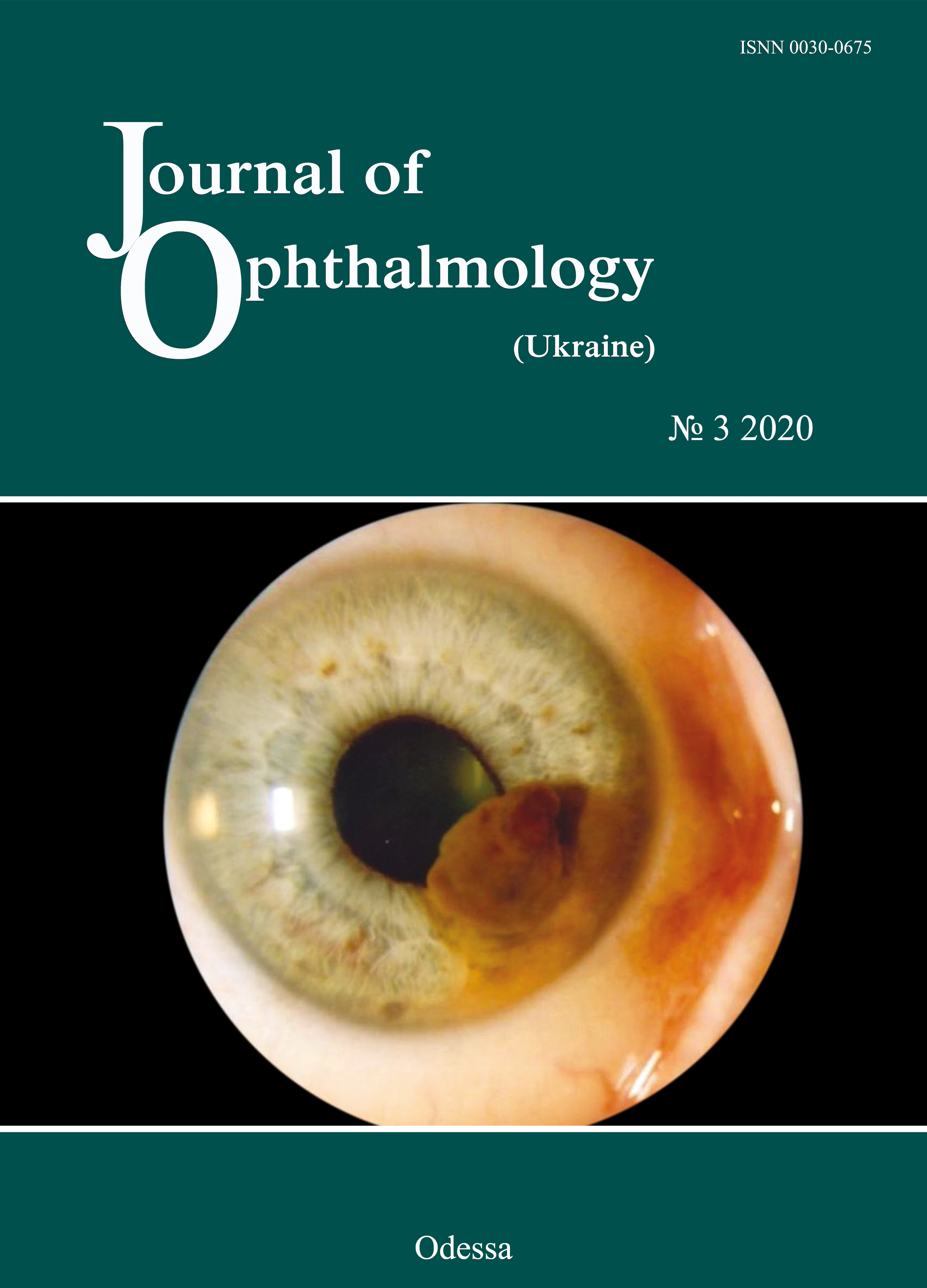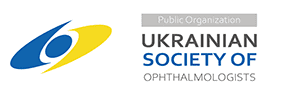Accelerated CXL for stage 2 to 3 progressive keratoconus: 24-month outcomes
DOI:
https://doi.org/10.31288/oftalmolzh202031622Keywords:
keratoconus, cornea, cross-linkingAbstract
Background: Ultraviolet (UV-X) corneal collagen cross-linking (CXL) involves photopolymerization of corneal collagen and in recent decades has been commonly employed for the treatment of stage 2 to 3 keratoconus. The high-intensity illumination of the UV-X™ 2000 Crosslinking System (Avedro, Inc., Waltham, Massachusetts) provides accelerated CXL (A-CXL), reducing treatment time threefold (to 10 minutes) compared with conventional CXL protocol.
Purpose: To assess 24-month outcomes of A-CXL for stage 2 to 3 progressive keratoconus.
Material and Methods: One hundred and nineteen patients (167 eyes) who underwent ACXL for keratoconus were included in this study. At 24 months, ocular changes were assessed in 40 eyes. A-CXL was carried out using the UV-X™ 2000 Crosslinking System at an irradiation intensity of 9 mW/cm?.
Results: Mean astigmatism decreased by 1.15 D to 3.02 ± 1.73 (SD) D (for n=40 eyes) and mean corneal refractive power as assessed by Kmax decreased by 3.4 D to 54.4 ± 6.62 (SD) D (median value, 54.3 D; n=40 eyes) at 24 months compared to baseline values. Mean thinnest local corneal thickness increased by 3.0 ?m (mean value, 462.7± 34.3 (SD) ?m; median value, 455.5 ?m; n=40 eyes; р = 0.009), mean uncorrected visual acuity increased by 0.2, and mean best-corrected visual acuity increased by 0.25 at 24 months compared to baseline values. Of the 40 eyes examined at 24 months, BCVA improved in 34 eyes (85%).
Conclusion: A-CXL for stage 2 to 3 progressive keratoconus resulted in a steady state of the pathological process, decrease in astigmatism by 1.15 D, decrease in corneal refractive power as assessed by Kmax by 3.4 D, and an increase in thinnest local corneal thickness by 3.0 ?m for the total study cohort, and improvement in BCVA in 85% of eyes at 24 months.
References
1.Bikbov MM, Surkova VK. [Corneal collagen crosslinking for keratoconus]. A review. Ophthalmology in Russia. 2014;11(3):13-8. ttps://doi.org/10.18008/1816-5095-2014-3-13-19. Russian.
2.Birich TA, Chekina AIu, Aksionova NI. [Outcomes of treatment for keratoconus]. Oftalmologiia Belorusi. 2010;1(4):90-7. Russian.
3.Ivanovskaia EV, Vit VV, Golovchenko VG. [Immunological status of patients with various stages of keratoconus and keratoglobus]. Oftalmol Zh. 2000;5:40-4. Russian.
4.Drozhzhyna GI, Troychenko LF, Naumenko VA, et al. [Outcomes of accelerated corneal collagen cross-linking in keratoconus]. Oftalmol Zh. 2018;3:10-7. Russian.
5.Sevastiianov EN, Gorskova EN, Ekgard VF. [Keratoconus (etiology, pathogenesis, medicinal treatment): textbook]. Cheliabinsk: UGMADO;2005. Russian.
6.Solodkova EG, Remesnikov IA. [Modern approaches in the treatment progressive keratectasia]. Prakticheskaia meditsina. 2012;4:75-9. Russian.
7.Croghale NS. Epidemiology of keratoconus. Indian J Ophthalmol. 2013;61(8): 382-3.https://doi.org/10.4103/0301-4738.116054
8.Rabinowitz YS. Keratoconus. Surv Ophthalmol. 1998 Jan-Feb;42(4):297-319.https://doi.org/10.1016/S0039-6257(97)00119-7
9.Georgiou T, Funnell CL, Cassels-Brown A, O'Conor R. Influence of ethnic origin on the incidence of keratoconus and associated atopic disease in Asians and white patients. Eye (Lond). 2004 Apr;18(4):379-83.https://doi.org/10.1038/sj.eye.6700652
10.Li X, Rabinowitz YS, Rasheed K, Yang H. Longitudinal study of the normal eyes in unilateral keratoconus. Ophthalmology. 2004;111:440-6.https://doi.org/10.1016/j.ophtha.2003.06.020
11.Gordon-Shaag A, Millodot M, Shneor E, Liu Y. Gordon-Shaag A, et al. The genetic and environmental factors for keratoconus. Biomed Res Int. 2015;2015:795738.https://doi.org/10.1155/2015/795738
12.Zadnik K, Barr JT, Edrington TB, et al. Baseline findings in the Collaborative Longitudinal Evaluation of Keratoconus (CLEK) Study. Invest Ophthalmol Vis Sci. 1998;39:2537-46.
13.Adel Alhayek, Pei-Rong Lu. Corneal collagen crosslinking in keratoconus and other eye disease. Int J Ophthalmol. 2015; 8(2): 407-18.doi: 10.3980/j.issn.2222-3959.2015.02.35.
14.Kohlhaas M, Spoerl E, Schilde T, et al. Biomechanical evidence of the distribution of cross-links in corneas treated with riboflavin and ultraviolet A light. J Cataract Refract Surg. 2006 Feb;32(2):279-83.https://doi.org/10.1016/j.jcrs.2005.12.092
15.Nowak DM, Gajecka M. The genetics of keratoconus. Middle East Afr J Ophthalmol. 2011 Jan;18(1):2-6.https://doi.org/10.4103/0974-9233.75876
16.Spoerl E, Mrochen M, Sliney D, et al. Safety of UVA - riboflavin cross - linking of the cornea. Cornea. 2007 May;26(4):385-9.https://doi.org/10.1097/ICO.0b013e3180334f78
17.Wollensak G, Spoerl E, Seiler T. Stress-strain measurements of human and porcine corneas after riboflavin/ultraviolet-A-induced cross-linking. J Cataract Refract Surg. 2003 Sep;29(9):1780-5.https://doi.org/10.1016/S0886-3350(03)00407-3
18.Kymionis GD, Portaliou DM, Bouzoukis DI, et al. Herpetic keratitis with iritis after corneal crosslinking with riboflavin and ultraviolet A for keratoconus. J Cataract and Refract Surg. 2007 Nov;33(11):1982-4.https://doi.org/10.1016/j.jcrs.2007.06.036
19.Macsai MS, Varley GA, Krachmer JH. Development of keratoconus after contact lens wear. Patient characteristics. Arch Ophthalmol. 1990 Apr;108(4):534-8.https://doi.org/10.1001/archopht.1990.01070060082054
20.Mazzotta C, Balestrazzi A, Traversi C, et al. Treatment of progressive keratoconus by riboflavin-UVA-induced cross-linking of corneal collagen; ultrastructural analysis by Heidelberg Retinal Tomograph II in vivo confocal microscopy in humans. Cornea. 2007 May;26(4):390-7.https://doi.org/10.1097/ICO.0b013e318030df5a
21.Meek KM, Tuft SJ, Huang Y, et al. Changes in collagen orientation and distribution in keratoconus. Invest Ophthalmol Vis Sci. 2005. 2005 Jun;46(6):1948-56.https://doi.org/10.1167/iovs.04-1253
22.McQuaid R, Cummings AB, Mrochen M. The theory and art of corneal cross-linking. Indian J Ophthalmol. 2013 Aug;61(8):416-9.https://doi.org/10.4103/0301-4738.116069
23.Spoerl E, Huhle M, Seiler T. Induction of cross-links in corneal tissue. Exp Eye Res. 1998 Jan;66(1):97-103.https://doi.org/10.1006/exer.1997.0410
24.Spoerl E, Seiler T J. Techniques for stiffening the cornea. Refract Surg. 999 Nov-Dec;15(6):711-3.
25.Sp?rl E, Huhle M, Kasper M, Seiler T. [Increased rigidity of the cornea caused by intrastromal crosslinking]. Ophthalmologe. 1997 Dec;94(12):902-6. German.https://doi.org/10.1007/s003470050219
26.Tsubota K, Mashima Y, Murata H, et al. Corneal epithelium in keratoconus. Cornea. 1995 Jan;14(1):77-83.https://doi.org/10.1097/00003226-199501000-00013
27.Wollensak G, Spoerl E, Seiler T. Riboflavin/ultraviolet-A-induced collagen crosslinking for the treatment of keratoconus. Am J Ophthalmol. - 2003 May;135(5):620-7.https://doi.org/10.1016/S0002-9394(02)02220-1
28.Shajari M, Kolb CM, Agha B, Steinwender G, M?ller M, Herrmann E, et al. Comparison of standard and accelerated corneal cross-linking for the treatment of keratoconus: a meta-analysis. Acta Ophthalmol. 2019 Feb;97(1):e22-e35.https://doi.org/10.1111/aos.13814
29.Sadoughi MM, Einollahi B, Baradaran-Rafii A, et al. Accelerated versus conventional corneal collagen cross-linking in patients with keratoconus: an intrapatient comparative study. Int Ophthalmol. 2018; 38: 67-74.
Downloads
Published
How to Cite
Issue
Section
License
Copyright (c) 2025 Л. Ф. Тройченко, Г. І. Дрожжина

This work is licensed under a Creative Commons Attribution 4.0 International License.
This work is licensed under a Creative Commons Attribution 4.0 International (CC BY 4.0) that allows users to read, download, copy, distribute, print, search, or link to the full texts of the articles, or use them for any other lawful purpose, without asking prior permission from the publisher or the author as long as they cite the source.
COPYRIGHT NOTICE
Authors who publish in this journal agree to the following terms:
- Authors hold copyright immediately after publication of their works and retain publishing rights without any restrictions.
- The copyright commencement date complies the publication date of the issue, where the article is included in.
DEPOSIT POLICY
- Authors are permitted and encouraged to post their work online (e.g., in institutional repositories or on their website) during the editorial process, as it can lead to productive exchanges, as well as earlier and greater citation of published work.
- Authors are able to enter into separate, additional contractual arrangements for the non-exclusive distribution of the journal's published version of the work with an acknowledgement of its initial publication in this journal.
- Post-print (post-refereeing manuscript version) and publisher's PDF-version self-archiving is allowed.
- Archiving the pre-print (pre-refereeing manuscript version) not allowed.












